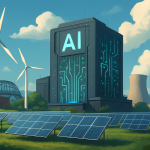Yesterday, the headlines screamed: President Trump, in a move that’s either visionary or audacious depending on your political leanings, announced a massive $70 billion investment in artificial intelligence and energy. The venue? Pittsburgh, Pennsylvania, ground zero for both industrial heritage and burgeoning tech innovation. The timing? Perfectly aligned with Senator David McCormick’s inaugural Pennsylvania Energy and Innovation Summit at Carnegie Mellon University. It was a trifecta of optics, policy, and, let’s be honest, good old-fashioned political theater.
But beyond the carefully curated image, what does this announcement really mean? Is this the dawn of a new era, a technological renaissance fueled by federal dollars? Or is it just another grand gesture, a shiny object designed to distract from, well, you know… everything else?
Let’s rewind a bit. The backdrop to this announcement is crucial. For years, the U.S. has been locked in a silent race with China and other global powers for AI supremacy. Think of it as a real-world version of Skynet, only instead of killer robots, the stakes are economic dominance, national security, and the future of pretty much everything. Couple that with the ever-present pressure to modernize our aging energy infrastructure, and you have a perfect storm of urgency and opportunity. This isn’t just about building better solar panels or faster algorithms; it’s about securing America’s future in a world increasingly defined by data and energy efficiency.
The specifics, as always, are shrouded in a bit of mystery. A White House official, speaking on background (because that’s how these things always go), hinted that the investments would be spread across various industries, with a particular focus on integrating AI into existing energy systems. Imagine AI-powered smart grids that can predict energy demand, optimize distribution, and even prevent blackouts before they happen. Or AI algorithms that can analyze seismic data to locate new sources of geothermal energy. The possibilities are, frankly, mind-boggling.
But here’s the rub: $70 billion is a lot of money, even by government standards. Where exactly will it go? Which companies will benefit? Will it trickle down to small businesses and startups, or will it primarily enrich the usual suspects- the tech giants and established energy conglomerates? These are the questions that industry leaders and policymakers are grappling with right now.
The potential implications are enormous. We’re talking about a potential boom in data center construction, a massive upgrade to our power grid, and the creation of countless new jobs in both the AI and energy sectors. Think of it as a modern-day New Deal, only instead of building dams and bridges, we’re building neural networks and smart grids. The administration is touting this as a way to reduce our dependence on foreign energy sources, bolster national security, and, of course, stimulate economic growth.
But let’s not get carried away just yet. Remember the hype around self-driving cars? We were promised a future where robots would chauffeur us around while we napped in the backseat. That future is still… well, in the future. AI is powerful, but it’s not magic. It requires vast amounts of data, skilled engineers, and, perhaps most importantly, ethical guidelines. Which brings us to the societal angles.
Who gets to decide how this AI is used? Who benefits from the energy revolution? Will it exacerbate existing inequalities, or will it create opportunities for everyone? These are the questions we need to be asking. The development and deployment of AI raise profound ethical questions. Algorithmic bias, data privacy, and the potential for job displacement are all legitimate concerns that need to be addressed head-on. It’s not enough to simply build the technology; we need to ensure that it’s used responsibly and ethically.
And then there’s the political dimension. This investment is undoubtedly a strategic move, designed to shore up support in key swing states like Pennsylvania. It’s also a way for the administration to project an image of technological leadership on the world stage. But will it be enough to silence the critics who argue that the administration’s policies are actually hindering innovation? Only time will tell.
From a purely financial perspective, this announcement sent ripples through the markets. Shares of companies involved in AI and renewable energy surged, while traditional energy stocks took a slight dip. It’s a clear sign that investors see the writing on the wall: the future is in AI and renewable energy, and those who fail to adapt will be left behind. The economic impact could be substantial, potentially creating trillions of dollars in new wealth and transforming entire industries. But it also carries risks. A sudden shift in energy policy could disrupt existing markets and lead to job losses in traditional energy sectors.
President Trump’s $70 billion investment is a bold gamble, a high-stakes bet on the future of AI and energy. It has the potential to transform our economy, strengthen our national security, and improve our lives in countless ways. But it also carries risks: ethical dilemmas, political pitfalls, and the potential for unintended consequences. As with any technological revolution, the key is to proceed with caution, foresight, and a healthy dose of skepticism. After all, as they say in Silicon Valley, “Move fast and break things.” But when it comes to AI and energy, maybe we should move a little slower and build things that last. The stakes are simply too high to get it wrong.
Discover more from Just Buzz
Subscribe to get the latest posts sent to your email.


